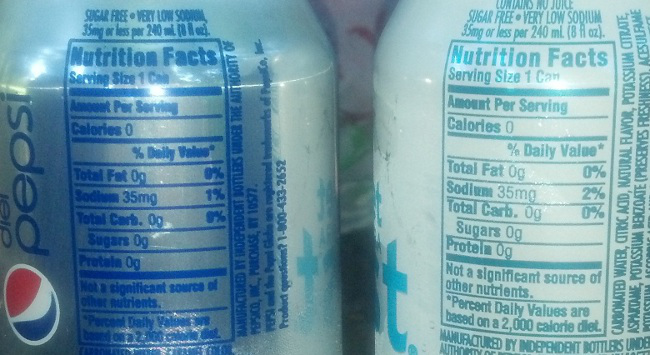Why The Math On Your Soda Bottles & Cans Doesn’t Always Add Up
In the two years since we first covered the complicated rounding involved with soda bottle nutrition labels, some changes have been made with the goal of clearing up things like calorie count and serving size. But some questions still keep popping up, so it’s probably time for a refresher course.
In just the past few days, we’ve received a couple e-mails from readers who were a bit puzzled by what they read in the nutrition information for their carbonated beverages of choice.
First up is the reader whose daughter noticed that while both Diet Pepsi and Diet Sierra Mist had 35 mg of sodium listed on the label, they each had different percentages under the “% Daily Value” column.
So how could the same number, when divided by the same denominator, result in a different percentage?
Welcome to the world of FDA rounding rules.
According to those rules, food products in this sodium range must be rounded to the nearest 5mg increment for sodium.
This means that the Diet Pepsi could have as low as 32.5 mg while the Sierra Mist could
be as high as 37.4 mg, but both would say 35 mg on the label.
And when companies figure out what to put in the “% Daily Value” column, they use the actual, non-rounded number.
For sodium, the FDA uses 2400 mg as to calculate recommended daily values.
Say the Diet Pepsi actually has 33 mg of sodium, which comes out to around 1.375% DV, rounded down to 1% for the label.
And if Sierra Mist has 37 mg of sodium, that would come out to 1.54% DV, rounded UP to 2% on the can.
Meanwhile, another reader wrote in curious about the math on his 20 oz. bottle of Dr. Pepper Ten, which advertises “10 Bold Tasting Calories Per 8 Fl. Oz.” on the front of the bottle. But then both the nutrition label and the new-ish “calories per bottle” burst on the bottle only list 20 calories for 20 ounces.
Obviously, it Dr. Pepper Ten were actually 10 calories/8 oz, that number should be 25 calories.
Once again, it’s those tricky rounding rules.
Back when we first wrote about rounding rules, companies still divided up 20 oz. bottles into 8 oz. servings, so you ended up with 2.5 servings even though it’s intended and marketed as a single serving.
That has since changed, with nutrition info for all sodas 20 oz. and smaller listed as “one serving.”
But the issue here is that Dr. Pepper Ten apparently has fewer than 10 calories per 8 oz. As long as that number is 7.5 or higher, it’s rounded up to 10 — and “Dr. Pepper 8.235” is nowhere near as catchy.
Again, the actual, non-rounded calorie count is used to figure out the total for the bottle. So assuming Dr. Pepper Ten actually has 8.75 calories per 8 oz, you end up with 21.875 calories in a 20 oz. bottle. That is then rounded down to 20 calories.
Hopefully this will help to clear up why looking at nutrition labels can sometimes make you wonder whether or not you’ve lost your basic math skills.
Want more consumer news? Visit our parent organization, Consumer Reports, for the latest on scams, recalls, and other consumer issues.


